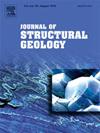Thickness of an extensional plate-boundary shear zone in the mantle: Implications for tectonic controls on strain localization and transient strain rates
IF 2.9
2区 地球科学
Q2 GEOSCIENCES, MULTIDISCIPLINARY
引用次数: 0
Abstract
This study shows that constant displacement rate conditions – imposed by plate tectonics – is the best approach to consider the evolution of extensional plate-boundary shear zones, as stresses vary during deformation. The Turon de Técouère massif of the French Pyrenees preserves a Cretaceous, magma-poor hyperextended plate margin within the lithospheric mantle. The massif exposes an extensional shear zone hosted in lherzolite. The present-day structure of the shear zone, frozen at 750 °C, consists of a ∼40 m thick ultramylonite, bordered by a ∼200 m thick mylonite and a protomylonite >100 m thick. The ultramylonite overprinted a ∼40 m-thick mylonite that was active between 1000 and 850 °C, while the shear zone became thicker with time. Using displacement rates, determined from tectonic analyses, and strain rate estimates, determined from microstructural analyses, the calculated thickness (8–20 m) of the shear zone is less than the observed thickness (40–200 m) at different temperature conditions experienced by these rocks. Therefore, the shear zone is thicker than necessary to accommodate the plate motion. This result indicates that the Turon de Técouère shear zone likely represents the entire divergent plate boundary at conditions of the lithospheric mantle. We introduce the concept of a “jump around” shear zone – in which a smaller zone of active shearing moves around within a thicker zone of deformation – to explain the discrepancy between the thinner shear zones predicted by strain rates and the thicker observed shear zone.

地幔中伸展板块-边界剪切带的厚度:构造对应变局部化和瞬态应变速率的控制意义
这项研究表明,恒定的位移速率条件——由板块构造施加——是考虑伸展板块边界剪切带演化的最佳方法,因为应力在变形过程中是变化的。法国比利牛斯山脉的Turon de tcoutre地块在岩石圈地幔内保留了白垩纪岩浆匮乏的超伸展板块边缘。该地块暴露出一个以橄榄岩为主的伸展剪切带。现今的剪切带结构在750°C冻结,由一个~ 40 m厚的超长花岗岩组成,边缘是一个~ 200 m厚的糜棱岩和一个100 m厚的原糜棱岩。在1000 ~ 850℃之间,超长玄武岩覆盖了一层~ 40 m厚的糜棱岩,而剪切带随着时间的推移而变厚。根据构造分析确定的位移率和微观结构分析确定的应变率估算,在这些岩石经历的不同温度条件下,剪切带的计算厚度(8-20 m)小于观测厚度(40-200 m)。因此,剪切带比适应板块运动所需的厚。这一结果表明,在岩石圈地幔条件下,Turon de t coutre剪切带可能代表了整个发散板块边界。我们引入了“跳跃”剪切带的概念——其中一个较小的活跃剪切带在较厚的变形带内移动——来解释应变率预测的较薄剪切带与观察到的较厚剪切带之间的差异。
本文章由计算机程序翻译,如有差异,请以英文原文为准。
求助全文
约1分钟内获得全文
求助全文
来源期刊

Journal of Structural Geology
地学-地球科学综合
CiteScore
6.00
自引率
19.40%
发文量
192
审稿时长
15.7 weeks
期刊介绍:
The Journal of Structural Geology publishes process-oriented investigations about structural geology using appropriate combinations of analog and digital field data, seismic reflection data, satellite-derived data, geometric analysis, kinematic analysis, laboratory experiments, computer visualizations, and analogue or numerical modelling on all scales. Contributions are encouraged to draw perspectives from rheology, rock mechanics, geophysics,metamorphism, sedimentology, petroleum geology, economic geology, geodynamics, planetary geology, tectonics and neotectonics to provide a more powerful understanding of deformation processes and systems. Given the visual nature of the discipline, supplementary materials that portray the data and analysis in 3-D or quasi 3-D manners, including the use of videos, and/or graphical abstracts can significantly strengthen the impact of contributions.
 求助内容:
求助内容: 应助结果提醒方式:
应助结果提醒方式:


